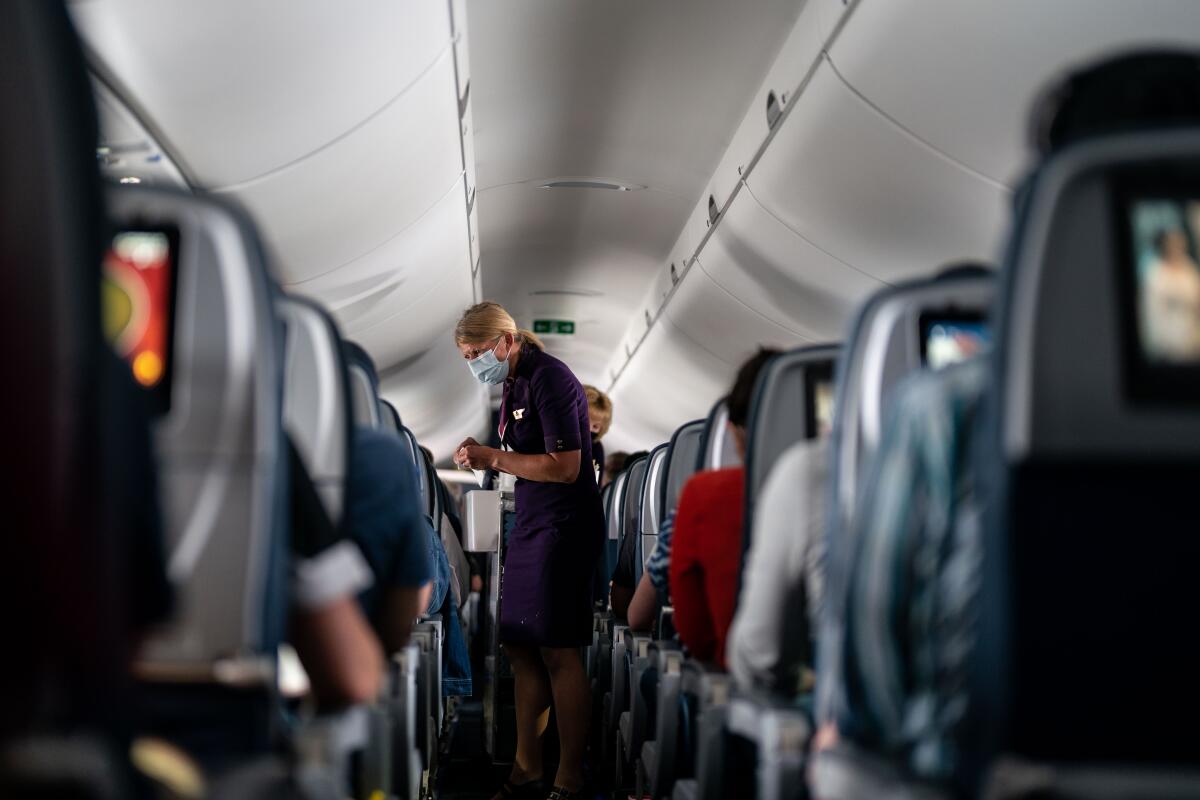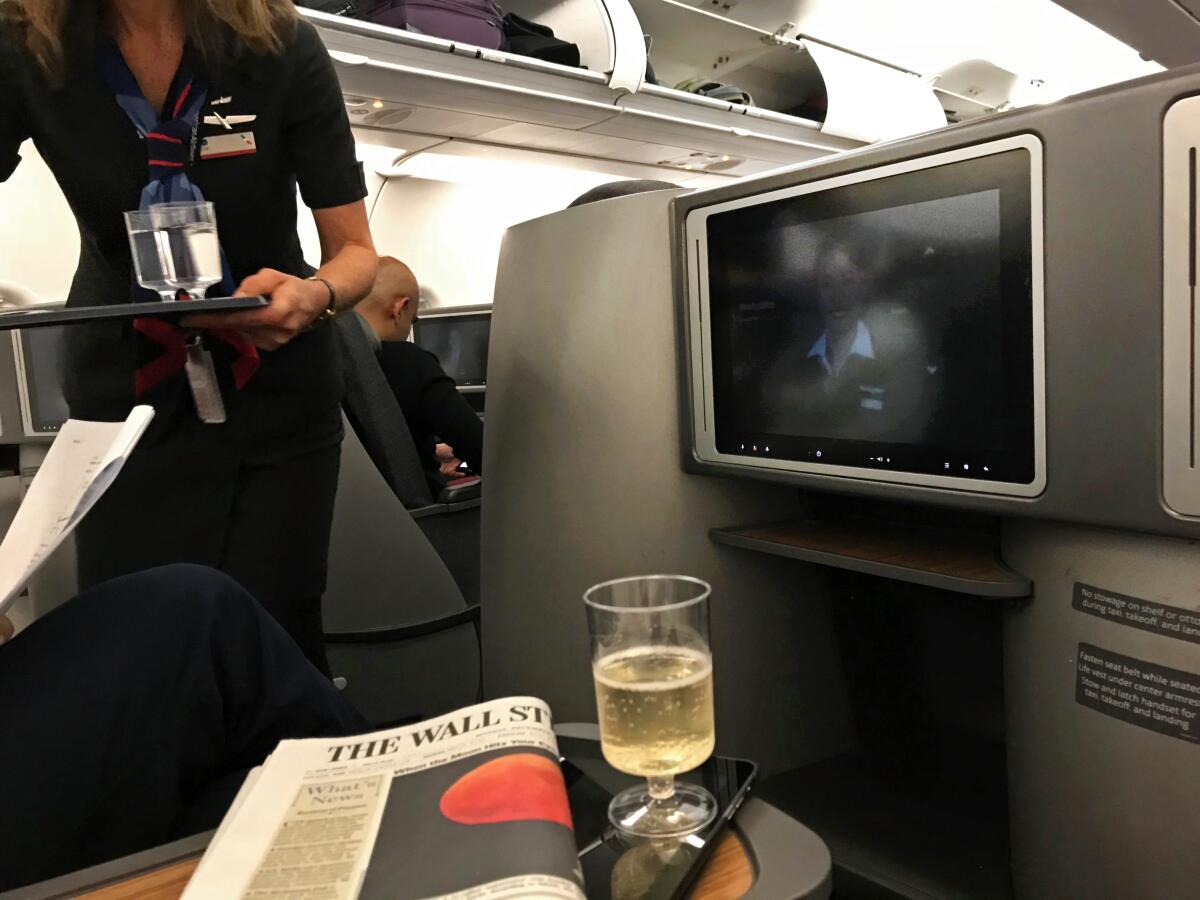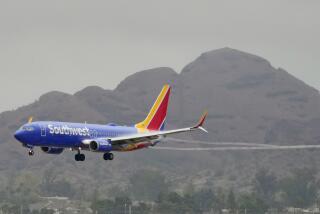Airplane food is back, but it’s not like you remember

- Share via
Full airline menus are back — but say goodbye to pre-meal cocktails, warm cookies and a lot of chitchat with your flight attendants.
After cutting most food service during the pandemic, airlines are once again offering premium dishes such as miso-marinated cod, Greek chicken salad and braised short ribs to entice the big spenders who buy first- and business-class seats.
But COVID-19 has forced changes in the way they serve food and drinks, as well as some usual offerings such as snacks, to reduce interaction between fliers and flight attendants.
“I miss that smell in the cabin,” Los Angeles resident Anasia Obioha said as she reminisced about the American Airlines chocolate chip cookies that were absent from her recent flights.
Obioha, who works in corporate communications, said her meals on several first-class flights to and from Mexico reminded her of the lunches served on trays in the cafeteria in elementary school. All her dishes were prepackaged and cold, she said.
To help return airlines to profitability, carriers are meeting the recent uptick in travel demand by expanding their onboard offerings to include the kind of high-end meals and drinks that were popular with first- and business-class travelers before the pandemic. After all, the nation’s airlines lost a combined $35 billion in 2020, after seven consecutive years of profitability, according to the U.S. Bureau of Transportation Statistics.
No one ever starved on a three-hour flight.
— Heather Poole, flight attendant
In-flight meals, drinks and airport lounges are not significant revenue generators but are essential to attracting first- and business-class fliers, who made up as little as 5% of all passenger traffic before the pandemic but generated about 30% of all passenger revenues, according to the International Air Transport Assn., an airline trade group.
“Airlines want to attract people who go to the upper- and first-class cabins,” said Michael Taylor, practice lead for travel at J.D. Power, a data analytics and consumer information company.
These passengers are coveted because they often book high-price last-minute tickets and buy the most expensive seats at the front of the plane.
Among the most noticeable changes in the cabin are to meal courses, previously dished out on separate plates in upper-class cabins. Now they get served all at once on large trays.
“We’re offering all courses at once to limit the handling of trays, dinnerware and glasses between our guests and flight attendants,” Alaska Airlines spokesperson Ray Lane said.

In the aisle, instead of pouring drinks into plastic cups from food carts, flight attendants are now handing passengers throughout the plane full cans or bottles of beer, soda, wine or hard seltzer to eliminate the pouring time.
Many of the changes to in-flight food service have been made at the behest of the nation’s flight attendants, who have been hit hard by the pandemic. An estimated 4,000 flight attendants on U.S. carriers have contracted the virus and 20 have died, according to the Assn. of Flight Attendants-CWA, which represents 50,000 flight attendants at 17 airlines.
“AFA has pressed airline management on aspects of food and beverage to ensure procedures best support fewer touch points or inconsistent masking,” said Sara Nelson, president of the association. “The Delta variant has caused cases to skyrocket again, threatening lives, continued virus mutation, and recovery from this pandemic.”
At airport lounges, covered dishes have replaced buffet-style food. Self-serve beverage dispensers are now staffed by lounge workers, or they’ve been eliminated altogether to reduce intermingling.
For some flight attendants, the changes are not enough.
Heather Poole, a flight attendant with more than 20 years of experience, said her fellow flight attendants are put at risk by serving passengers who lower their masks for too long to nurse a drink or take their time eating a snack. She would prefer that airlines return to eliminating all food and drinks on short flights.
“No one ever starved on a three-hour flight,” Poole said.
A federal mandate that requires all airline passengers to wear masks when not eating or drinking has added to the demands on flight attendants who are tasked with trying to enforce the mask policy. Most of the nearly 4,000 incidents of unruly passengers in 2021 involve disputes over the mask mandate, according to the Federal Aviation Administration.
American Airlines has stopped selling alcoholic beverages in the main cabin at least until Jan. 18, and Southwest Airlines has paused all alcohol sales indefinitely, partly in response to a growing number of incidents of unruly passengers that resulted in assaults on flight attendants and other passengers.
Delta has stopped offering premium passengers cocktails before a meal. Now beverages are served with the meals to reduce the contact between passengers and flight attendants.
Most airlines began cutting back or eliminating food and beverage sales on planes and closing airport lounges in March 2020 to help slow the spread of the virus. Some airlines limited the onboard service to boxed meals for long-haul and international flights. Other airlines encouraged passengers to bring their own snacks.
Within a few months, airlines began to offer passengers packaged snacks and drinks, with full meals reserved for long-haul and international flights.
As coronavirus case numbers dropped this summer and air travel demand began to increase, airlines expanded their food and beverage offerings. The recent surge in cases tied to the Delta variant has not altered the airline industry’s food and drink expansion plans.
Alaska’s chief financial officer, Shane Tackett, told analysts in an earnings conference call June 30 that the airline was about to return to “our full catering complement.”
“So more people getting more food and beverages similar to where we were pre-COVID,” he said. “They’re coming back with demand, and they’re all coming back in the third quarter pretty strong.”
As part of the newly enhanced meals, United Airlines recently announced the addition of scrambled eggs with plant-based chorizo and grilled chicken breast with orzo and lemon basil pesto. The Chicago-based carrier also teamed up with Chicago’s Eli’s Cheesecake to develop a chocolate pie flavor called “Pie in the Sky.”
On Alaska Airlines, premium fliers can indulge in a chile-lime salad and miso-marinated cod with sesame garlic farro, sautéed bok choy, bell peppers and shiitake mushrooms.
On Delta, first- and Delta-One-class passengers flying on select routes are offered lemon ricotta pancakes with blueberry thyme syrup, smoked salmon and beef short ribs with whipped potatoes.
But the soft drinks given to fliers in the main cabin and “comfort plus” seats are not in the traditional 12-ounce cans — they get the “mini” 7.5-ounce cans.
Eric Rose, a partner in a lobbying and crisis communications firm in Los Angeles, described the lunch on a recent Delta flight from Los Angeles to New Orleans as “very sterile.” The prepackaged sandwich served in the business-class section was cold and his request for a Scotch on the rocks was answered with a small bottle of Scotch and a cup of ice.
“This is the new reality until COVID is under control,” Rose said.
More to Read
Inside the business of entertainment
The Wide Shot brings you news, analysis and insights on everything from streaming wars to production — and what it all means for the future.
You may occasionally receive promotional content from the Los Angeles Times.











